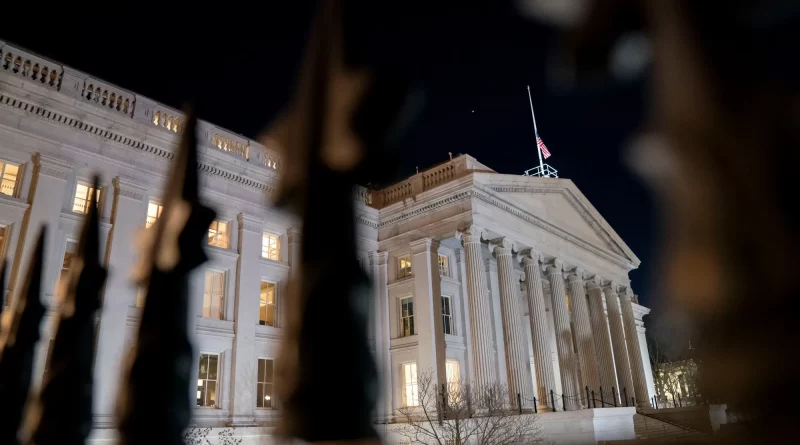Treasury yields descend toward year’s lows on tariff angst
US government bond yields shifted back toward the lowest levels of the year amid mounting investor conviction that a trade-induced growth slowdown will lead the Federal Reserve to cut interest rates multiple times in 2025.
Aided by a drop in the price of crude oil to a six-month low, the Treasury market rallied after a gauge of hiring by US companies fell short of nearly all economist estimates for February. Some of the gains were pared following a subsequent stronger-than-anticipated report on services and a historic selloff in German government bonds. A broader gauge of US February job gains is set for release on Friday.
Yields on two-year notes — more sensitive to Fed interest-rate changes than longer maturities — led the move to lower levels, falling nearly 10 basis points to 3.89% before rebounding to around 3.95%. The 10-year note’s was little changed around 4.25% after falling to 4.18%. Across maturities, Treasury yields touched 2025 lows on Tuesday.
“It’s a bullish environment for Treasuries,” said Padhraic Garvey, regional head of research at ING Groep. “I suspect the 10-year can’t go below 4% just yet,” though Friday’s employment data “will be key” as weakness could lower the expected floor for the Fed’s policy rate, he said.
The US Treasury market has gained 2.7% this year through Tuesday as measured by a Bloomberg index, with a 2.5% advance since mid-February amid accumulating indications of slowing economic activity.
Investors in recent weeks have pivoted from viewing US President Donald Trump’s tariffs agenda as potentially inflationary to focusing on negative economic consequences. The focus on federal government job and spending cuts are also a factor.
The Trump administration is considering a one-month delay for automakers from newly imposed tariffs on Mexico and Canada as a temporary reprieve following pleas from industry leaders, according to people familiar with the matter.
The February jobs report is expected to show that US nonfarm payrolls increased by 160,000 in February, according to the median of a Bloomberg survey of economists. Anna Wong of Bloomberg Economics said payrolls may even have contracted because of the sudden retrenchment of state and local government hiring after the Trump administration froze federal financial assistance programs.
Swap traders are pricing in slightly less than even odds that the Fed will resume cutting interest rates in May. For all of 2025, the contracts imply nearly three-quarters of a percentage point of easing.
“The front-end of the Treasury curve is starting to get rich with the market pricing in three Fed cuts through the end of the year,” said Brij Khurana, portfolio manager at Wellington Management. “While this is possible, the recent unemployment data has meant that the Fed can return its focus to inflation. The Fed will want to be cautious on further cuts in case inflation turns up again,” even given the Trump administration’s policy focus so far.
The sticking point for central bankers is inflation that continues to exceed their 2% long-term target. The Fed paused cutting rates in January, following three cuts totaling a percentage point last year, after progress toward lower inflation stalled.
In Wednesday’s ISM services report, a gauge of prices paid by businesses component of the ISM services unexpectedly increased, along with gauges of new orders and employment.
Commerce Secretary Howard Lutnick, speaking on Bloomberg Television Wednesday, said he’d “bet on the economic growth that is coming from Donald Trump.” He added that “you are going to see the greatest equity market and bond markets under President Trump.”
Still, a survey of JPMorgan Treasury clients published Tuesday showed wagers on further gains — so-called net bullish positions — were at their highest level in 15 years. And demand for options to hedge against further price increases is on the rise.
“Treasury yields are definitely the corner of the market where we are seeing the economic worries play out,” said Baylor Lancaster-Samuel, chief investment officer at Amerant Investments Inc. “The downside risks of the new administration’s policies are capturing the zeitgeist — higher tariffs, stickier inflation, and lower growth — which means that Treasuries are catching a bid.”
German government bonds yields surged Wednesday, with the 10-year rising the most in a day since 1990, as investors braced for an increase in borrowing to fund defense and infrastructure investments. That came after chancellor-in-waiting Friedrich Merz outlined a sweeping fiscal overhaul that could boost the European economy.

